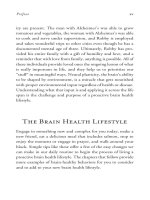The 5 Things You Must Do to Keep Your Mind Young and Sharp_9 pot
Bạn đang xem bản rút gọn của tài liệu. Xem và tải ngay bản đầy đủ của tài liệu tại đây (244.01 KB, 15 trang )
Critical Area 3: Mental Stimulation 119
programs. The work setting can also be an environment that
provides opportunities for mental stimulation. It is important
to fi rst review your own behavior in the workplace and to assess
how you might be able to derive more mental stimulation dur-
ing your typical workday.
Most employees complete work duties on a daily basis that
tend to be predictable and routinized. As such, employees spend
a good deal of their time stimulating their subcortex, the part of
the brain that helps with procedures and skills that require pro-
cessing that is subconscious. The goal of a brain health environ-
ment is to provide novel and complex stimuli that engage and
stimulate the cortex, help to build brain reserve, and maintain
conscious processing. Consider the following for ways you can
stimulate your brain at work:
• As an employee, you are encouraged to try new tasks and
activities in your work setting. This will increase process-
ing of stimuli that are novel and complex and increase the
chance for brain health benefi t.
• Do not be afraid to express your creative ideas and provide
time for employees to imagine. Integration of diverse dis-
ciplines can help to forge new ideas that otherwise might
tend to remain in operational silos.
• When leading a meeting, consider setting the chairs of the
room in a circle or several small circles rather than rows and
columns. This can engage everyone in a more integrated
rather than didactic manner. A more integrated approach
can promote personal interaction and constructive dialogue.
Save Your Brain120
• Ask human resources if your company provides any assis-
tance for you to enroll in formal lifelong learning that
might occur at a local college or university or within the
work setting itself.
• Ask if you can assume roles that will nurture your commu-
nication skills, including public speaking and provision of
succinct responses that are both clear and informative. Ask
your information offi cer if the company has technologies
to assist your own daily tasks and if you can learn about
the different software.
• Ask if you can establish a type of brain health kiosk in the
work setting where employees can access information on
the basics of the human brain and the brain health life-
style, complete their online brain fi tness workout, get the
latest research news on the human brain and brain health,
and even complete their online brain health survey to
assess the strengths and weaknesses of their brain health
lifestyle.
Mental Stimulation in Other
Areas of Your Life
You can take a brief inventory of the environments you typi-
cally traverse on a daily basis. Most of us spend a healthy por-
tion of our time at home, which is why a previous section was
dedicated to mental stimulation in the home. However, we also
spend time in other settings, such as our work site and maybe
Critical Area 3: Mental Stimulation 121
a gymnasium, library, or facilities where we recreate or enjoy
entertainment. Once you have a conscious sense of where you
typically spend your time, you can analyze the value of novelty
and complexity that each environment provides you. The goal
is to expose your brain to settings that provide activities and
stimulation that are novel and complex. You can do this and
still have some fun along the way! The following brain-health-
promoting tips can be used in different areas of your life to
promote mental stimulation:
• Try new tasks and activities in your daily life. Some ideas
would be to accomplish your typical daily tasks using a
different approach, or maybe you could reach your desti-
nation using a different route. By changing your approach,
you will be providing your brain with novelty and com-
plexity and therefore boost your brain health benefi t.
• Try to develop one or two new hobbies over the next year.
A hobby really is the development of a new talent, and
this requires stimulating your brain to develop the neural
circuitry that enables you to perform the task or hobby.
You can learn how to use a new computer program, or
you can take up golf or tennis, gardening or knitting. So
long as the new activity is new for you, your brain will be
stimulated in a healthy way.
• As the brain is pleased with multiple and simultaneous
stimuli, consider and encourage communication and learn-
ing or teaching that engages multiple sensory systems. We
all tend to rely heavily on our visual and auditory systems
Save Your Brain122
to the neglect of our ability to taste, smell, and touch. Your
brain can be stimulated using all the sensory pathways.
• Break out of intellectual silos and share knowledge. Per-
haps most important from the perspective of brain health
is the need to integrate and merge different bodies of
knowledge, academic and applied, to form an entirely
new intellectual or tangible entity (intellectual alloy). This
is accomplished by getting groups of people to think dif-
ferently and to merge their talents and knowledge with
those of others. Most of the time we operate in silos with
complete focus on our own goals and deadlines. We can
enhance brain health and promote creativity, imagination,
and innovation by breaking down silos and merging the
content within the silos—the benefi t being that mental
stimulation, creativity, and new answers to old problems
can emerge from this sharing of knowledge.
These are just a few tips to get you started—there are so
many ways to engage your mind. Mental stimulation is critical
to brain health. Your brain is constantly seeking and process-
ing information. The wonderful thing about the human brain
is that it changes and responds to the types of environmental
input provided. This fact provides all of us the opportunity
to select specifi c settings or environments that provide the
most brain-health-promoting stimuli, so immerse yourself in
enriched environments to keep your brain sharp and fi t.
Critical Area 3: Mental Stimulation 123
Tips to Promote Brain Health: Quick Review
• Keep an active reading habit. This can include a book or two a month,
reading the newspaper every day, and a favorite magazine on a weekly
basis.
• Enroll in a brain fi tness program like those found on fi tbrains.com.
You can engage in daily activities that stimulate memory, language,
attention, visuospatial, and executive skills.
• Engage in new activities that are challenging. Try to learn a new lan-
guage or learn how to play a new instrument.
• Be artistic and creative. Pick up a hobby like painting, making pottery,
or any other activity that promotes your imagination.
• Enroll in a class or workshop that interests you, perhaps a class on
public speaking or even course offerings available through corporate
learning centers.
This page intentionally left blank
125
8
Critical Area 4:
Spirituality
I turned inward and became one with my world.
7
S
pirituality is another critical area that promotes brain health,
and at fi rst you may be skeptical, but in this chapter, I will
show you how spirituality is directly connected to a health-
ier brain. When I talk about spirituality, I’m not necessarily
addressing religion but rather engagement in deep introspec-
tion or meditation as part of the human condition. Although
spirituality can be both formal, religiously inspired, as well as
informal, using modes of introspection gained from such things
as meditation, spirituality in the context of a brain health life-
style is broadly defi ned as action or behavior that helps us slow
down, turn inward, and rid our bodies of toxic stress.
Since the beginning of time, humans have engaged in
behaviors we refer to as religion or spirituality or a belief in
a higher power. For many years this reality has been resisted,
wars continue to be fought over such matters, and deep intra-
Save Your Brain126
personal confl ict revolves around spirituality. I believe that we
should not deny this reality but rather embrace it as part of our
DNA and ask questions about whether and how spirituality can
enhance our human condition and, in the case of this book, our
brain health.
Encouraging Research That
Connects Brain Health
and Spirituality
I am not the only one who is interested in spirituality and the
human brain, as an entire new fi eld called “neurotheology” has
developed to study this exact topic. To date, scientists have
reported that prayer, which can be considered a form of medita-
tion, on a daily basis enhances the immune system. The brains
of monks in deep meditation as measured by PET (positron-
emission tomography) scans, which measure levels of glucose
metabolism, evince change as if there is no distinction between
processing of what is going on outside the human brain from
inside. This has potential signifi cance as our brain typically
differentiates processing information and activity that occurs
inside versus outside of our brain. It appears from the PET
scans that deep meditation removes the internal versus external
processing and instead integrates the internal and external into
a unifi ed existence. Perhaps this is why those who meditate
describe a peaceful existence. Persons who attend formalized
Critical Area 4: Spirituality 127
religious service report happier lives and have healthier lives,
and over 90 percent of American physicians report that prayer
is important to the well-being of their patients. This is certainly
a good start on trying to understand the relationship between
our spirituality and health. With continued research, we will
learn more and perhaps even have the courage to prescribe
spiritual behaviors as part of our overall treatment regimen for
patients in need.
Other research within the fi eld of neurotheology has focused
on the structural and functional relationship between our rec-
ognition of God and the human brain. I have seen reports that
suggest our temporal and parietal lobes are primary sites for the
relationship, but this is not conclusive. We know that temporal
lobe epilepsy, in which a person will experience abnormal elec-
trical activity within the cells of the temporal lobe, is associated
with hyperreligiosity and even delusions of grandeur in which
one may believe he or she is God. Research is ongoing to under-
stand this relationship between God and brain so we can better
explain why and how humans seek a higher being and how that
impacts the function of the brain and our overall condition.
I have noticed that most people are a bit timid when talking
about spirituality, but as I mentioned earlier, spirituality does
not necessarily always go hand in hand with religious beliefs.
Spirituality has many meanings, and it may mean something
different to you than me. This section refers to spirituality as
one means of turning inward to foster a peaceful existence and
to remove oneself from the hurried society. Sometimes spiri-
tuality takes the form of engaging in prayer, meditation, and
other relaxation procedures.
Save Your Brain128
Stress: Implications for
Brain Health
Why is it so important for humans and for the human brain to
not be hurried, overwhelmed, rushed, or stressed? We all know
how bad it feels when we’re hurried or stressed, which also neg-
atively affects us emotionally or behaviorally; what’s also impor-
tant to realize is this kind of anxiety affects our brain health
as well. When our body and brain are at ease, we can achieve
a relaxed state of being, one that enables our brain and body
to perform at their most effi cient level. Ridding our body and
brain of the daily bombardment of stress and reaching a type of
inner homeostasis is important, but diffi cult to achieve.
The Importance of Balance
Homeostasis is a term that refers to balance, symmetry, and
smoothness that exists within our body. Our brains also expe-
rience homeostasis, which is a blissful state without anxiety,
stress, or feeling rushed or troubled. We all feel this bliss at
times, though it may be fl eeting and temporary. More often,
we experience a lack of homeostasis, and there can be signifi cant
negative consequences to our health and even our longevity
if this imbalance becomes chronic. Disorders such as hyper-
tension, obesity, addiction, depression, anxiety, somatic con-
ditions, interpersonal tension, impulsivity, and even criminal
Critical Area 4: Spirituality 129
behavior can relate to or even be caused by chronic stress and
lack of balance in our minds.
We need to seek this homeostatic state by engaging in relax-
ation techniques such as prayer or meditation to reduce stress
and achieve a balanced mind. This is as true for everybody
from the person who works at home to the typical business
professional all the way to an executive of a powerful company.
Often we ignore this effort because we live in a fast-paced and
demanding world that limits our ability to achieve such balance.
It is important to fi rst recognize the importance of balance, the
fact that you are often in too big a hurry and too stressed, and to
respect the negative health consequences of losing balance and
homeostasis. Once you understand this, you can begin to make
a conscious effort to identify behaviors in your own lifestyle
that reduce your balance and to make the necessary changes for
your health and brain health.
Research: Highly Stressed Environments
Lead to Memory Loss
Animal research has found that rodents raised in an environ-
ment that is too stimulating demonstrate slowed brain devel-
opment. In addition, animals exposed to environments that
are highly stressful, where they have
little control, demonstrate
structural damage in their hippocampus and evince memory
problems.
Early research on the human brain exposed to life- threatening
stressors indicates there is a similar effect on the hippocampus.
Save Your Brain130
Also, humans with chronic anxiety often have memory prob-
lems, which supports the theory that stress and uncontrolled
anxiety have a negative effect on brain function. Research has
even shown that chronic stress that can emerge from poverty
in childhood has been related to increased risk of Alzheimer’s
disease later in life. In other words, stress can have both an acute
and long-term effect on the body and brain. The point of this
research, human and animal, is that we humans should take
pause and examine how fast we are moving on a daily basis and
decide if we need to slow down.
With chronic stress, some organisms undergo a type of sus-
tained hormonal explosion; a proliferation of steroid hormones
will infi ltrate the brain of animals and perhaps humans. These
steroid hormones are thought to be primarily responsible for
the structural damage to the hippocampus and the negative
consequence of memory loss and forgetfulness. Humans with
post-traumatic stress disorder (PTSD) experience a therapeutic
benefi t from ongoing psychotherapy, and their cognition can
return to near normal or even normal with successful therapy.
This indicates that the potential damage from chronic stress can
be reversed and further highlights the power of neural plasticity
and brain health.
Critical Area 4: Spirituality 131
Promote Brain Health
Through Spirituality
The goal of stress reduction can be accomplished, but it is
not easy. We do need to be educated on the effects of stress
on our body and brain, identify our own behaviors that con-
tribute to increased stress and loss of balance, and then make
changes in our lifestyle to promote balance. This is a lifelong
battle, and it can be diffi cult, particularly in any culture that
teaches “the quick fi x.” Three good behaviors to learn and to
implement for achieving a healthier spirituality include prayer,
meditation, and deep relaxation. Each of these three behaviors
involves turning inward from the chaotic outside pressures and
stress and reaching a type of internal peace. This can help to
achieve the homeostasis and balance necessary for brain health
described earlier.
Research and surveys have reported the following positive
effects of prayer on health:
1. Prayer on a daily basis relates to an enhanced immune sys-
tem, the system that helps you defend against colds, fl u,
and other illnesses.
2. Those who attend a formalized place of worship live lon-
ger and report happier and healthier lives than those who
do not. Unfortunately, surveys suggest only 30 percent of
people in the United States attend a formalized place of
worship weekly.
Save Your Brain132
3. Prayer (or meditation) as part of the daily routine while in
the hospital relates to an earlier discharge. I would think
the health care payer system would fi nd this interesting!
Brain Health Tip
Consider incorporating meditation, other relaxation techniques such as
breathing exercises, or even prayer into your daily health routine.
Meditation and Relaxation Exercises
Meditation, relaxation procedures that include deep breathing,
and progressive muscle relaxation are important to brain health.
Unfortunately, we tend to use Band-Aid approaches, and we
really do not fi x the underlying problems or struggles of our
lives. It is fair to say that a high number of “conditions” suf-
fered by humans are stress-related and can probably be cured
by changing certain lifestyle behaviors and by discovering the
underlying cause of the stress and remedying it through spiri-
tual introspection.
Meditation. Meditation can help you to slow down and turn
inward for balance and symmetry. Your brain can adapt to
a chaotic world, but it will function more effi ciently over a
longer period of time if you provide moments of inward refl ec-
tion and rest. Meditation offers one technique to achieve such
inner peace, and Western cultures are now more accepting of
meditation and yoga.
Critical Area 4: Spirituality 133
Part of your brain health program can include a lesson or
two on meditation so you can engage in this behavior on a
daily basis. Fortunately, other cultures have already embraced
the power of meditation and the benefi ts derived from deep
introspection. The growing popularity of meditation makes it
easier to fi nd various kinds of guided meditation techniques
online like how-to-meditate.org.
Breathing Exercises. Similarly, you may not know how to
breathe correctly or to use breathing techniques to rid your
body of stress. You are encouraged to engage in proper relax-
ation breathing exercises two to three times daily. Taking a deep
inhalation through your nose using your stomach muscles and
holding the breath for several seconds will result in your feeling
some tension in your stomach and chest. Now, slowly release
the air using your stomach and pushing the air out of your
mouth in a rhythmic way. Doing this exercise several times for
a few minutes throughout the day can help you to slow down
and gain a sense of calm as you rid yourself of toxic stress.
Listen to Your Body’s Stress Indicators. It is important not
only to identify the stressors in your life but also to understand
and locate what part of your body is vulnerable to stress. You
may experience stress in your neck, lower back, head, or stom-
ach. By identifying what part of your body stress targets, you
can then engage in progressive muscle relaxation procedures to
alleviate the stress from your target site. For example, squeeze
your right hand into a fi st as hard as you can. Hold the fi st and
pay attention to how uncomfortable the tension is in your fi st.









